Orchid Show at New York Botanical Garden
By bathgate
34 comments
Let’s go visit the Orchid Show at the New York Botanical Garden. Orchids are among the most exquisite plants on earth, some will delight you, others will offend you, but all will intrigue you. Let’s take a look…

The Lorillard Family owned most of the land which became The New York Botanical Garden. That land and adjacent acreage was acquired by the City of New York and set aside for the creation of a zoo (The Bronx Zoo) and botanical garden. The Garden was established on 28 April 1891 on part of the grounds of the Lorillard Estate (formerly owned by the tobacco magnate Pierre Lorillard). The Garden’s creation followed a fund-raising campaign led by the Torrey Botanical Club and Columbia University botanist Nathaniel Lord Britton and his wife Elizabeth Gertrude Britton who were inspired to emulate the Royal Botanic Gardens in London. It was declared a National Historic Landmark in 1967

Garden highlights include an 1890s-vintage, wrought-iron framed, “crystal-palace style” greenhouse by Lord & Burnham, now Haupt Conservatory; the Peggy Rockefeller Rose Garden (originally laid out by Beatrix Jones Farrand in 1916); a rock garden; a 37-acre (15 ha) conifer collection; extensive research facilities including a propagation center, 550,000-volume library, and an herbarium of over seven million botanical specimens dating back more than three centuries. At the heart of the Garden are 50 acres (20 ha) of old-growth forest, the largest remnant the original forest which covered all of New York City before the arrival of European settlers in the 17th century.

Let’s step out of the bustling city and into the Florida Keys, where the dramatic beauty of a flourishing tropical garden is amplified by vibrant architecture that recalls this particular island’s charm and ambience. The Enid A. Haupt Conservatory’s sprawling glasshouse galleries are transformed into a modernist Key West estate garden, where an effusion of orchids—including Vanda (rainbow orchids), Dendrobium (cane orchids), and Cymbidium (Asian corsage orchids)—bloom among still, geometric reflecting pools, soaring angular pergolas, and sleek benches.






Orchids thrive in almost any environment around the
world, from deserts to rain forests.


Having evolved and adapted in order to survive and reproduce in such a wide variety of habitats, orchids grow in almost any size, color, and shape imaginable.
There are an estimated 30,000 naturally occurring orchid species and tens of thousands of artificially created hybrids.


Some orchid species mimic bees, wasps, butterflies, and moths; others have unusual buckets, traps, and trigger mechanisms. These adaptations help to ensure that insect pollinators visit the flowers.





Orchids in Nature
Now let’s see how orchids grow in nature. A majority of orchids are perennial epiphytes, which grow anchored to trees or shrubs in the tropics and subtropics. Species such as Angraecum sororium are lithophytes, growing on rocks or very rocky soil. Other orchids (including the majority of temperate Orchidaceae) are terrestrial and can be found in habitat areas such as grasslands or forest. This is how you would expect to see orchids growing in nature…






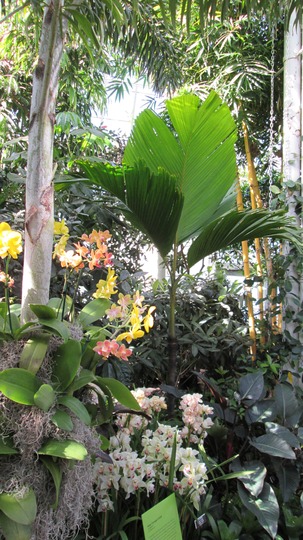






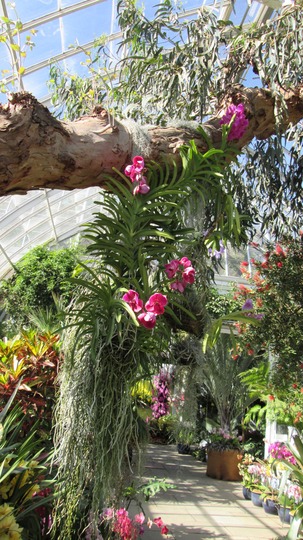

Phalaenopsis
If you are lucky enough to have a Phalaenopsis, you are about to enter the wonderful world of growing orchids! Phals are one of the easiest orchids to grow in the home. If you follow a few basic requirements, these plants will reward you with several months of beautiful blooms.



It is best to water in the morning. Place the plant in the sink and use tepid water. Do not use salt-softened or distilled water. Let the water run through the plant for a minute or so. Be sure to let the plant drain completely.
If any water remains in the crown (where the leaves join in the center) use a paper towel to blot the water to avoid crown rot.



Phalaenopsis are ‘low’ light orchids. They grow beautifully in an east window and can be grown in a south or west window if protected by a sheer curtain. A phal’s leaves should be olive green. If they are darker it means the plant is not getting enough light; red tinged leaves mean the plant is getting too much light. Once the plant is in bloom you can place it anywhere in your home out of direct sunlight. If your plant does not re-bloom, increase the amount of light that it receives.
Continue watering and fertilizing while waiting for the blooming cycle to begin!



Phals are easy to grow because they enjoy the same temperatures we do – above 60º F at night and a range of 70º F to 80º F or higher during the day. 95º F is the maximum temperature recommendation. Keep in mind that temperatures close to the window on a windowsill will be colder or hotter than your general house temperature. Fluctuating temperatures can cause bud drop on plants with buds ready to open.








Any balanced orchid fertilizer (look at the numbers on the container, 20-20-20, etc.) can be used to fertilize your orchid. Feeding weakly (half strength) weekly works well. Once a month, use clear water to flush any accumulated salts from the potting mix.







Vanda Sansai Blue Orchid
Blue orchids are somewhat rare flowers even some of its species are in danger of extinction. The reason is that their natural environment is being destroyed.
This one is called Vanda Sansai Blue Orchid





Cattleya
Cattleyas are among the most popular orchids. Their culture is often used as the basis for comparison with other types of orchids. Cattleyas and their related hybrids come in many colors, shapes, forms and sizes.







Slipper Orchids
Thought to be one of the slowest-growing plants in the world, the lady’s slipper orchid takes between 6 and 11 years of growth before it actually produces flowers. The seeds are minute, dust-like particles that contain no food reserves. The materials needed for germination are derived from a symbiotic association with a mycorrhizal fungus. Orchids can be difficult to propagate in artificial conditions for this reason, but the lady’s slipper orchid has been studied and successful ex-situ propagation techniques have been devised. It is dormant in winter, does not form tubers, but has creeping rhizomes.







Check out these other interesting specimens…





































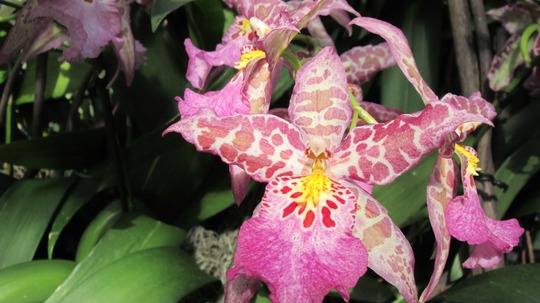



Asian Corsage Orchid
Cymbidium species are the most widely known of all orchids. The native species are not widely cultivated which is a great benefit in preserving them in their native habitat, whereas Cymbidium hybrids are the most popular orchids grown and easily lend themselves to cultivation. They require bright light and cool nights. Many cymbidium hybrids can be quite large yielding as many as 20-30 blooms or more on a single spike.








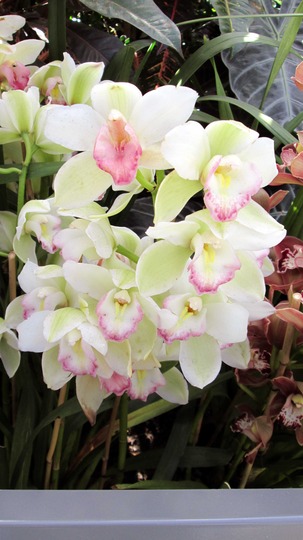




Darwin’s Star Orchid is a rare treat for visitors to this year’s Orchid Show. Like the vanilla orchid, it’s seldom they get to flaunt this beauty in full bloom.


Aren’t Orchids amazing? They can devise buckets, triggers and traps to catch pollinators! I wonder if I can even grow these….

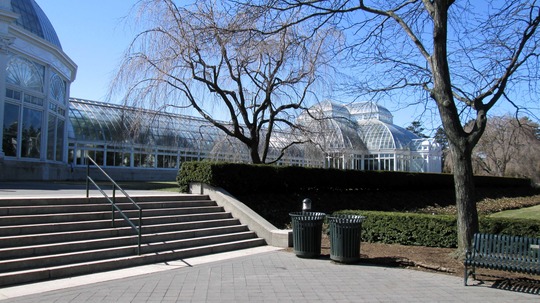
What a nice looking tree…I wonder what kind it is…

Thanks for spending the day with me…

I know that’s a White Birch Tree.

There’s my train…I should make it home in time for dinner…


 22 Mar, 2014
22 Mar, 2014 13 likes
13 likes
Next post: Flowering Trees of New York City
Comments
what a fantastic informative blog. Thank you for sharing as I doubt I will ever get to visit it in the flesh.
22 Mar, 2014
Thankyou Paul on my wish list as you know I have had the pleasure twice at Singapore Botantical Garden .
Thankyou so much for sharing your excellent photos.
Did you make it home for Dinner?
22 Mar, 2014
very botanical...
22 Mar, 2014
Firstly Paul,well done on your very first blog..I know how long it took you to compile this..Congratulations,it is wonderful,thank you .:o)
As you know I love Orchids too,but I'm amazed just how many varieties there are..I've never heard of Cattleyas before..
There is no way I could choose a favourite amongst these,as every time I think I've found one,I see another as I scroll down..:o) This is going on my Favourites,so I can keep looking back at my leisure..
Just glad you posted all these on a blog,instead of separate photo's..much easier on the eye,to see them all altogether,with all the accompanying information,which is so interesting too..
I hope you post more blogs,now you have made
a start,and hope Costello wasn't waiting for his dinner either ! Lol x
22 Mar, 2014
Thank you all for your kind comments. I'm glad to be able to share this with you. Scotkat - the Garden is only a 20 minute ride from Grand Central on Meto North, had time for dessert too - :)
22 Mar, 2014
Thank you Sandra. It was a wonderful show. I really felt like I was on a tropical Island someplace - Key West as the theme goes. I appreciate your support and good advice in composing this blog. You pointed me in the right direction to start off, then it all just flows from there. I hope to do more in the future. I'm glad you enjoyed the show. :)
22 Mar, 2014
I did,Paul,and glad you soon got the hang of a blog..easy when you know how,isn't it? It took me a lot longer than you..! lol..
22 Mar, 2014
A thoroughly enjoyable blog. I don't grow orchids and knew very little about them. I know a lot more now! Thanks for making such an effort - I can't help but think it must have taken you an absolute age to put on that many pictures.
22 Mar, 2014
What a marvelous variety and all so beautiful.
22 Mar, 2014
Thank you for your comments. You are very welcome. It was a bit of a task putting this together, but something I've always wanted to do.
22 Mar, 2014
wonderful blog...so enjoyed reading it this morning with my coffee..:-)
23 Mar, 2014
Yes Sandra it really is an excellent blog I have nominated it for Orchids
23 Mar, 2014
you did it! Wow! A Monstrous feat putting all of that together is right. They are beautiful and each pic better than the next. I also loved that you showed the place and
the Botanical Gardens. How many hundreds of kinds they have...I think even I who love to look would have been undone. It's funny because I had a sister who lived in KeyWest and she learned all about them there. I rounded up a few and have tried all kinds of tricks and the most simple of all will not rebloom. Patience, patience patience.
I find that most plants do better if you don't overdo your care for them. But, naturally, everyone does in the beginning. But your blog should be called to the attention of all, am so glad you did it! And Thanks.
24 Mar, 2014
Thank you so much for your kind remarks. I am so glad you enjoyed it and I'm happy to share it with you. I don't exactly have a "green thumb" either for orchids. They are a bit of mystery to me, I do appreciate their exquisite beauty and how complex some of them are.
24 Mar, 2014
had to look again, it's a stunner. I particularly like the Apricot ones.
26 Mar, 2014
They are special aren't they? I'm so glad you enjoyed it. :)
26 Mar, 2014
That really is an outstanding set of pictures and information thanks for sharing.
Look forward to the next show you visit.
B
27 Mar, 2014
Thanks Bjs. I'm really glad you enjoyed it. I'm not sure what I'll be doing next, but I'm sure something will come up.
27 Mar, 2014
Wow!!!!!!! that was a treat..
I do not know how come I missed this blog, thankyou so much for all the work and time you must have spent putting all these lovely photo's and all the information together, I love orchids and although I have three seemingly healthy specimens, I have never been able to get them to bloom again,.
Off now back up the page to enjoy another look , also added to my favourites....
10 Oct, 2014
Thank you for your comment. I'm so glad you joyed the orchid show.
10 Oct, 2014
Lovely blog Paul. What a variety of Orchids. I never knew there were so many different ones. I only have two orchids that keep on growing from year to year. They always flower for months and send up lots of healthy aerial roots. When they finish flowering I cut the steams short just above a bud coming and we repot them every year. Also feed them with orchid feed and water with rainwater.
24 Dec, 2015
That's eye candy deluxe. Did you take any of the tropical ferns? So many are small jewels that can only be enjoyed closeup.
24 Dec, 2015
I've seen them there, but this visit I just focused on the orchids - they had so many rare and exotic orchids on display. very exciting. Thanks for your comment. I'll be going back there soon.
24 Dec, 2015
Even better then the last time. I've gotten a minor Orchid bug in me since I posted last. Some Moths...then bought a Laelia princeps. Its hardy outdoors here. I took a few kiki Dendrobium kingianum and mounted them on a Cyathea medullaris trunk.
All of these are actually subtropicals that like cool nights. They get those all year here near SF-lol.
Right now..I'm on the lookout for orchids I can mount on tree's. My first try with them doing that.
8 May, 2016
Thank you Cariad18. I'm so glad you enjoyed the blog. Visiting the "Garden" is the only way I"ll get to see so many rare and exotic plants.
Stan: I really love those 'lady slipper' or 'bucket' orchids. They are not the easiest plants to find but are worth the search.
8 May, 2016
:)
8 May, 2016
Those photos are gorgeous! Most of those plants grow outside here or under lath.
18 Feb, 2017
Its nice to see them grown to perfection. I have some kind of Dendrobium..fighting to flower in the cold outdoors. Some spotting.
Cattleya's are the real shocker. Do fine.
18 Feb, 2017
Yes, and I loved the Dypsis decipiens and Verschaffeltia splendida pics! Verschaffeltia splendida is an extremely difficult palm to grow here in San Diego. Of course, D. decipiens is very hardy! D. decipiens grow so slowly, though. However, love the large royal palm-type trunks when they get large!
18 Feb, 2017
Bath gate,
I do remember this blog. The plants are so beautiful! They’re grown to perfection!
I definitely remember the beautiful Verschaffeltia splendida
11 Feb, 2021
Thanks for visiting. Glad you enjoyed it. I'd like to go back again - soon.
11 Feb, 2021
Featured on
Recent posts by bathgate
- JAWS
6 Jul, 2021
- An Angel Flies Home: Goodbye Dawn
1 Jun, 2021
- Possibilities
27 May, 2020
- The Amityville Horror House
20 May, 2020
- Butterflies
27 Mar, 2020
- Grasses of Fire Island
16 Feb, 2020
Members who like this blog
-
Gardening with friends since
28 Jan, 2014 -
Gardening with friends since
12 Feb, 2009 -
Gardening with friends since
22 Apr, 2008 -
Gardening with friends since
9 May, 2011 -
Gardening with friends since
25 Jun, 2009 -
Gardening with friends since
25 Feb, 2011 -
Gardening with friends since
22 Jun, 2011 -
Gardening with friends since
9 Aug, 2009 -
Gardening with friends since
9 Apr, 2008 -
Gardening with friends since
28 Feb, 2011 -
Gardening with friends since
5 May, 2010 -
Gardening with friends since
22 Oct, 2008 -
Gardening with friends since
9 Sep, 2008


A wonderful blog. Thank you for all the good advice.
I must write it out in a notebook for when I buy another
Orchid, to replace mine that died.
Feel as though I have been on a visit to New York.
This blog demonstrates the tremendous world wide
generosity of gardeners, and Goy is so good to us all.
22 Mar, 2014